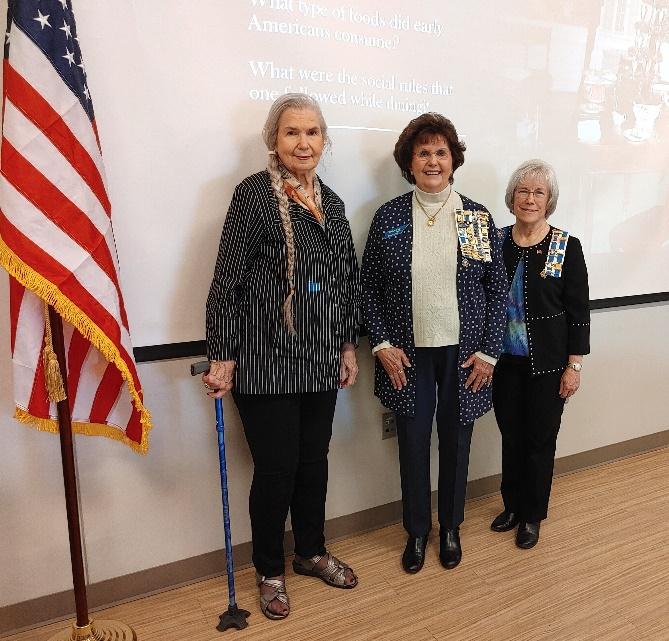Dining in Early America
The preparation and consumption of meals in early America was quite different from what it is today. For one thing, all dishes were “made from scratch,” and cooking at the hearth was energy and time-consuming. Some of the foods, cookware, and serving ware would strike a 21st Century family as quite unusual.
Diana West, DAR Museum Correspondent Docent, presented the program, “Dining in Early America,” at the March meeting of the Martha Dandridge Washington Chapter (MDW), National Society, Daughters of the American Revolution (NSDAR). Speaker West is also the Past and Honorary Regent and current Registrar of the Emory Road Chapter, NSDAR.
MDW Chapter members were entertained and informed by the fascinating presentation showing period rooms and their contents in the DAR Museum in Washington, D.C. From the inception of the DAR, a goal of the organization has been to collect and preserve historical objects that give the visitor a taste of life in past times. Thirty period rooms are designed to interpret American life during various decades from 1690 through 1930, and a different state sponsors each room.
Speaker West noted, “In Colonial America, the kitchen was the multi-purpose and multi-functional center of the home.” She specifically covered the 18th and 19th centuries. The center of most activity was the hearth where meats and vegetables were boiled and roasted, bread and cakes were baked, and water was boiled for tea and coffee.
Every home had a coffee grinder. Modern people may have fun grinding coffee at the supermarket; however, colonial cooks did not have a choice. They had to hand-grind coffee beans whenever they wanted to prepare the favorite drink. Poached or boiled fish was popular, so every colonial kitchen had a fish kettle. Spices were frequently used to make food interesting. Without the convenient racks of ground spices that we have today, the colonial cook had to use a spice grinder to pulverize the whole spices.
Because hearth cooking requires constant attention, cooking took up a large part of the day for wives or servants. A large fire was built in the morning and allowed to burn down to coals. “The coals were used to create small burners around the hearth,” West explained. This allowed cooks to adjust to different temperatures needed for such varied tasks as boiling or baking. The original use of the iron trivet was to be placed over coals and act as a stand to keep the teapot out of the direct fire.
Salt and pepper shakers like we use today did not exist. Cooks used salt cellars, little bowls from which the salt was spooned and sprinkled.
Pewter dishes and spoons were common. However, forks and knives were originally used for carving and serving food and rarely appeared on the 18th century table. They were very common table utensils by the 19th century.
Lots of familiar vegetables such as potatoes, turnips, carrots, and cabbage commonly made it to the table; however, many made it there in the form of puddings such as “Potatoe Pudding” prepared according to the following recipe recorded by Hannah Bloomfield: “Take one pound of washed potatoes, three quarters of a pound of butter, three quarters of a pound of sugar, Seven Eggs. One gill of Brandy. One gill of rosewater and another of cream. Work the butter and potatoes together, beat the sugar and eggs to a froth and then mix the whole. Bake them of a good puffed Paste.” A gill (pronounced jill) is four fluid ounces.
Whereas the kitchen served as the dining area and sometimes a sleeping area during the 18th century, the 19th century saw the emergence of the dining room. Tablecloths were used on upper-class tables, and knives and forks were common. Homes with dining rooms often had servants or enslaved persons to prepare and serve meals.
The sideboard became a fixture in the dining room. The piece of furniture was used to store dinnerware and linens and to provide a place to set serving dishes.
Some unusual items an upper-class dining room included were the cellarette, a cabinet for storing liquor, and the dumbwaiter, a multitiered table where the food items could be placed until the host served them. That eliminated the need of having a servant stand near the table to serve. The epergne (pronounced ay pern’) was a large, branched silver table centerpiece that held fruit or flowers.
Just as today, 18th and 19th century “domestic engineers” could set a table as simply or elaborately as their tastes and purses could afford.
For information about the DAR, contact MDW Registrar Karen McFarland at (865) 258-8670 or Regent Janet Guyett at (865) 712-8782.
 (L to R) Martha Cummings, DAR Museum Correspondent Docent and Organizing Regent of the Emory Road Chapter, NSDAR, accompanied Diana West, DAR Correspondent Docent and Guest Speaker, at the March meeting of the MDW Chapter, NSDAR. MDW Regent Janet Guyett hosted them. West presented a program titled, “Dining in Early America,” supported by a PowerPoint showing period rooms in the DAR Museum in Washington, D.C.
(L to R) Martha Cummings, DAR Museum Correspondent Docent and Organizing Regent of the Emory Road Chapter, NSDAR, accompanied Diana West, DAR Correspondent Docent and Guest Speaker, at the March meeting of the MDW Chapter, NSDAR. MDW Regent Janet Guyett hosted them. West presented a program titled, “Dining in Early America,” supported by a PowerPoint showing period rooms in the DAR Museum in Washington, D.C.










